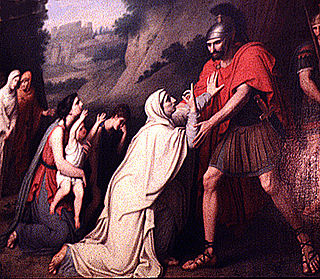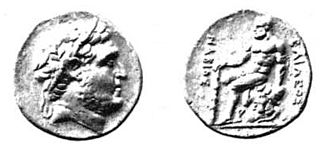Related Research Articles

The 5th century BC started the first day of 500 BC and ended the last day of 401 BC.
The 6th century BC started the first day of 600 BC and ended the last day of 501 BC.

Year 490 BC was a year of the pre-Julian Roman calendar. At the time, it was known as the Year of the Consulship of Camerinus and Flavus. The denomination 490 BC for this year has been used since the early medieval period, when the Anno Domini calendar era became the prevalent method in Europe for naming years.
This article concerns the period 499 BC – 490 BC.
This article concerns the period 519 BC – 510 BC.
This article concerns the period 489 BC – 480 BC.

GnaeusMarcius Coriolanus was a Roman general who is said to have lived in the 5th century BC. He received his toponymic cognomen "Coriolanus" following his courageous actions during a Roman siege of the Volscian city of Corioli. He was subsequently exiled from Rome, and led troops of Rome's enemy the Volsci to besiege the city.
Year 492 BC was a year of the pre-Julian Roman calendar. At the time, it was known as the Year of the Consulship of Macerinus and Augurinus. The denomination 492 BC for this year has been used since the early medieval period, when the Anno Domini calendar era became the prevalent method in Europe for naming years.
Year 488 BC was a year of the pre-Julian Roman calendar. At the time, it was known as the Year of the Consulship of Rutilus and Furius. The denomination 488 BC for this year has been used since the early medieval period, when the Anno Domini calendar era became the prevalent method in Europe for naming years.
The year 510 BC was a year of the pre-Julian Roman calendar. In the Roman Empire, it was known as year 244 Ab urbe condita. The denomination 510 BC for this year has been used since the early medieval period, when the Anno Domini calendar era became the prevalent method in Europe for naming years.
Hippias was the last tyrant of Athens, ruling from 527 to 510 BC. He was one of a group of tyrants known as the Peisistratids, which was a group of three tyrants in Ancient Greece. Pisistratus first, and then his son, Hippias, followed after him by Hippias' illegitimate son, Hegesistratos. He was deposed when Cleomenes I of Sparta successfully invaded Athens and forced him to flee to Persia.
Cleomenes I was Agiad King of Sparta from c. 524 to c. 490 BC. One of the most important Spartan kings, Cleomenes was instrumental in organising the Greek resistance against the Persian Empire of Darius, as well as shaping the geopolitical balance of Classical Greece.

Nabis was the last king of independent Sparta. He was probably a member of the Heracleidae, and he ruled from 207 BC to 192 BC, during the years of the First and Second Macedonian Wars and the eponymous "War against Nabis", i.e. against him. After taking the throne by executing two claimants, he began rebuilding Sparta's power. During the Second Macedonian War, Nabis sided with King Philip V of Macedon and in return he received the city of Argos. However, when the war began to turn against the Macedonians, he defected to Rome. After the war, the Romans, urged by the Achaean League, attacked Nabis and defeated him. He then was assassinated in 192 BC by the Aetolian League. He represented the last phase of Sparta's reformist period.
Demaratus was a king of Sparta from around 515 BC to 491 BC. The 15th of the Eurypontid line, he was the first son born to his father, King Ariston.
Leotychidas II was king of Sparta between 491–476 BC, alongside Cleomenes I and later Leonidas I and Pleistarchus. He led Spartan forces during the Persian Wars from 490 BC to 478 BC.

Philopoemen was a skilled Greek general and statesman, who was Achaean strategos on eight occasions.
Hippocrates was the second tyrant of Gela and ruled from 498 BC to 491 BC. He was the brother of Cleander and succeeded him to the throne after his death in 498. With him, Gela began its expansion phase; Hippocrates aimed to conquer all of southeastern Sicily in order to build a great state with Gela as its capital. He formed an alliance with Agrigento and conquered Zancle, Camarina, Catana, Naxos and Leontini. He also managed to besiege Syracuse, but had to withdraw, due to Corinthian and Corcyran involvement in the war. During his government, his city became the most powerful and flourishing among the Greek colonies in Sicily. Hippocrates died in battle against the Sicels. He designated his sons, Euclides and Cleander, as his successors, but they were soon replaced by the commander of the cavalry, Gelo who became the new tyrant of Gela.

Arruns Tarquinius, commonly called Egerius, was a member of the royal family of early Rome.

The first Persian invasion of Greece, during the Greco-Persian Wars, began in 492 BC, and ended with the decisive Athenian victory at the Battle of Marathon in 490 BC. The invasion, consisting of two distinct campaigns, was ordered by the Persian king Darius the Great primarily in order to punish the city-states of Athens and Eretria. These cities had supported the cities of Ionia during their revolt against Persian rule, thus incurring the wrath of Darius. Darius also saw the opportunity to extend his empire into Europe, and to secure its western frontier.

Eurysthenes was a descendant of the Spartan king Demaratus.
References
- ↑ "The Greeks - Themistocles". www.pbs.org. Retrieved November 30, 2022.
- ↑ "Hippocrates, Tyrant of Gela, fl.498-491". www.historyofwar.org. Retrieved November 30, 2022.
- ↑ "Gnaeus Marcius Coriolanus | Roman legendary figure | Britannica". www.britannica.com. Retrieved November 30, 2022.
- ↑ "Roman Timeline of the 5th Century BC | UNRV". www.unrv.com. Retrieved November 30, 2022.
- ↑ "Fortuna Muliebris, Roman Goddess of the Luck of Women". www.thaliatook.com. Retrieved November 30, 2022.
- ↑ "Art: Procession of Tribute Bearers". Annenberg Learner. Retrieved November 30, 2022.
- ↑ "The Dr. Norman Solhkhah Family Assyrian Empire Gallery | The Oriental Institute of the University of Chicago". oi.uchicago.edu. Retrieved November 30, 2022.
- ↑ "Gelon | tyrant of Gela and Syracuse | Britannica". www.britannica.com. Retrieved November 30, 2022.